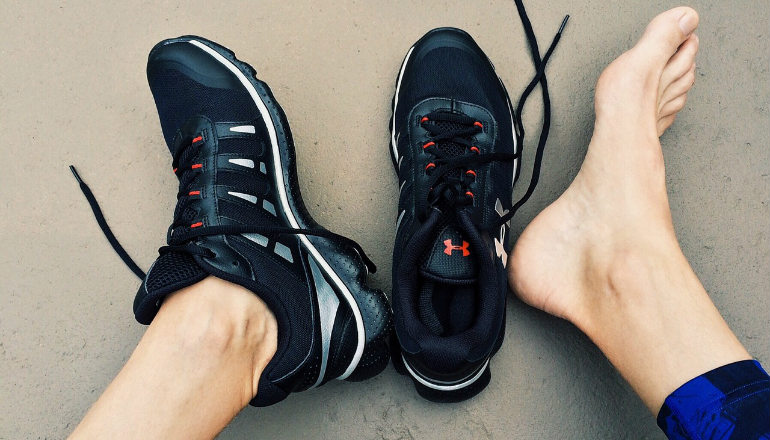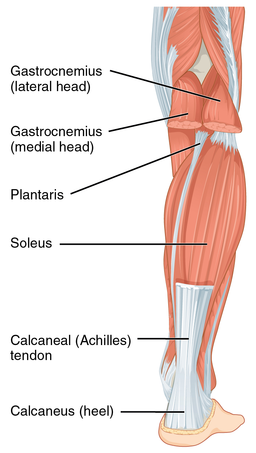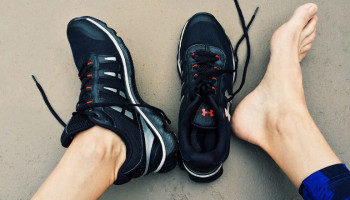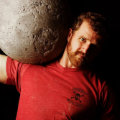 Reading Time: 5 minutes
Reading Time: 5 minutesI bet you never thought your heart and your ankle mobility could be connected.
It’s a little-known fact, but poor ankle mobility can be a cause of poor circulation. Today, we’re going to talk about why that is — and I’ll show you some practices that will loosen up your ankles and improve your circulation.
The Muscles of Your Lower Leg
 First, let’s begin with the muscles in your lower legs. There are two main muscles below the knee:
First, let’s begin with the muscles in your lower legs. There are two main muscles below the knee:
The first is the gastrocnemius — or gastroc, as I’ll refer to it in this article. This is the muscle that we refer to as our calf muscle. The gastroc is a primary mover in our body and responsible for proper locomotion, whether it be walking, running, or cycling. The gastroc is also part of our Achilles’ tendon, which connects to our calcaneus, or heel bone, and assists with ankle stability. On the other end, the gastroc connects across the back of the knee and overlaps with our hamstrings to provide stability and power to our knees and legs.
The second main lower-leg muscle is the soleus, a smaller and less known muscle of great importance. The soleus is a lot smaller than the gastroc — it’s even hidden between the gastroc and the shin bone. Consequently, this little guy is often forgotten when it comes to basic body maintenance. The soleus muscle itself is relatively short, but it has a long thin tendon that runs along the shin, partially wraps around the inside ankle bone that protrudes outward from your leg, and then connects just in front of it. Like the gastroc, the soleus aides in locomotion and stability.
What does all this have to do with the heart? I’m glad you asked.
How Your Circulation Works
Let’s take a step back and go over how your circulation works. There are two sets of vessels that move blood through the body: your arteries and your veins. Arteries have their own electrical input, similar to the heart, that makes them pump oxygen-rich blood from the heart throughout the body.
The veins don’t have an electrical input like the arteries. Instead, they rely on muscle contraction and one-way valves to pump the blood back to the heart. The valves keep deoxygenated blood from flowing backward, while the muscle contractions keep the blood moving back to the heart to be refreshed with oxygen — and thus the circle of life continues.
The Link Between Ankle Mobility and Your Heart
When we’re standing, sitting, or doing any number of daily activities, the gastroc and soleus are at the lowest point in the body. Not only does that mean they have to aid our blood in getting all the way back up to the heart, but it also means that blood has the longest way to travel.
When we don’t maintain the pliability of our gastroc and soleus muscles, we inhibit their ability to get our blood moving back to our heart. This prevents our blood from being refreshed at the rate it needs to be. It keeps vital oxygen and nutrients from reaching our lower extremities. It also keeps the less nutritious blood backed up in our lower legs.
This stagnation can lead to varicose veins, poor circulation, and movement issues related to tight muscles. These movement issues can include weak and/or stiff ankles and calves, plantar fasciitis, and pulled muscles and tendons from being pushed beyond their capabilities.
What do we do about all this? Another fantastic question, keep ‘em coming.
I’m going to show you some basic mobility techniques you can use on your gastroc and soleus. By regularly making use of these techniques, you can keep these muscles pliable and open a new range of motion. Doing this will not only maintain but improve on the mobility and blood flow you already have.
How to Stretch Your Calf Muscles
This first video details some stretches you can do anywhere and at any time. By changing the angle of your knee, you can target either the gastroc or the soleus. Make use of both the stretches in this video to keep yourself up to par.
Self-Massage for Healthier Lower Legs
In this video, I’m going to show you a self-massage technique you can do when you’re sitting in a chair or on the ground. You can use either your hands or a massage/mobility tool if your hands aren’t strong enough to really dig into this hard-to-reach muscle.
Remember that the soleus is often overlooked and may be in pretty bad shape at first. Be patient with yourself. With time and persistence, you can loosen you lower legs and improve your ability to move freely.
How to Foam Roll for Ankle Mobility
An article about your gastroc wouldn’t be complete without a brief discussion of foam rolling. While it isn’t as great for targeting your soleus, the foam roller and the gastroc go together like peanut butter and jelly.
Love Your Ankle Mobility to Love Your Heart
As I always, mobility is a great daily practice that you should implement sooner rather than later — and it’s important we don’t skip over our ankle mobility. Because the longer we go through life building on our anatomical issues (which we all harbor in some capacity) instead of tearing them down, then the longer and more difficult it’s going to be to turn our movement — and, in this case, our heart health — around toward the positive.
Stay mobile, my friends.





